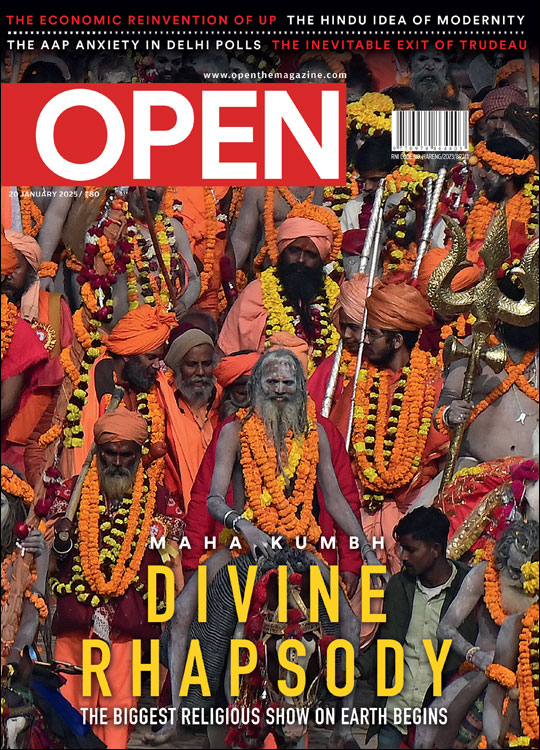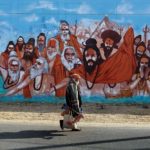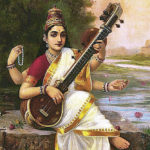Why Vivekananda Matters More Today
Swami of the mind
 Makarand R Paranjape
Makarand R Paranjape
 Makarand R Paranjape
Makarand R Paranjape
 |
20 Dec, 2018
|
20 Dec, 2018
/wp-content/uploads/2018/12/Vivekanand.jpg)
A COUPLE OF YEARS BACK, ON SWAMI VIVEKANANDA’S birthday tithi according to the Hindu almanac, I found myself through sheer grace at Belur Math, on the outskirts of the great colonial metropolis of Kolkata. This is the international headquarters of the Ramakrishna Math and Mission, the order of monks and the movement that Vivekananda founded on May Day, 1897, in the name of his guru, Sri Ramakrishna. There were hundreds of monks from different parts of India and the world attending events, helping in the arrangements, meeting the thronging visitors and blessing those who cared to bow down to them. It was a joyous and festive occasion.
I was fortunate to meet senior Swamis of the order, including the general secretary, Swami Prabhananda, and the vice-president of the order, Swami Suhitananda. A seemingly casual conversation with the latter, which I am sure he himself must have forgotten, gave me an insight into why Vivekananda matters all the more today. Swami Suhitananda asked me how I came to be so interested in Vivekananda as to produce two or three books on him. I said, “When I was still a graduate student at the University of Illinois, my teacher, Professor Giri Tikku, put the Gospel of Sri Ramakrishna into my hands. Whatever I learnt about spirituality and sadhana started seriously with that book.” There was a silence before I added, a bit haltingly, “But I’ve never been able to write about Thakur [Sri Ramakrishna]… I am stuck with Swamiji [Vivekananda].” With an enigmatic smile, Suhitananda ji said, “Thakur himself has ensured that Swamiji has taken hold of you—he will make you work!”
The reply startled me. “What was Swamiji’s work? How could I be a part of it?” The answer to that question also came, also somewhat unexpectedly, from another monk of the Ramakrishna Mission serving at the Ramakrishna Mission Institute of Culture (RMIC), Gol Park, Kolkata. This is a unique institution, quite an oasis in the heart of the busy city, quite close to Jadavpur University, with a lovely garden, several seminar rooms and auditoria, impressive library, active school of languages, significant publication section, top-notch academic and cultural programmes, wonderful dining and lodging facilities, and, of course, a beautifully elevating meditation hall and temple. Nurtured and expanded by the great Swami Lokeshwarananda, RMIC has made an indelible impact on the intellectual and cultural life of India.
But the monk posted to RMIC was not happy. Sorely overworked, he confessed that he cried before portraits of the trinity— Sri Ramakrishna, Holy Mother and Swami Vivekananda— anguished that he had no time for his sadhana, so occupied was he from morning till night. “I had joined the order to progress spiritually, but now I found that I had no spare time even to pray or meditate.” I was rather taken aback by his admission. “As monks,” he continued, “we have to serve society. But sometimes people misunderstand our kindness or affection.” “Swamiji , isn’t that the nature of human relations in the world as we know it?” I wondered. “That’s it,” he returned, “worldly people usually consider affection as a sign of weakness. They come to press some demand or the other on, trying to take advantage. Pure, unmotivated kindness is something so out of their normal arrangements… what a pity!”After a moment’s reflection, the Swami reverted to his original theme. “One day, I got the answer to my question. It was as if Swamiji [Vivekananda] was saying to me, ‘Don’t worry about your own moksha or liberation. That will come in due course. No need to be so selfish as concentrate on individual sadhana. This is the time to spread spirituality among the masses. Humanity itself awaits a massive transformation.”
THE WORK THAT SWAMI VIVEKANANDA came to do was this great transformation of the human condition. This is a truth that few of his many million admirers fully understand or know. That is because his short life of less than 40 years (1863-1902), especially the last nine after his spectacular debut at the Parliament of World’s Religions in Chicago, was marked by such extraordinary dynamism and activity in the public sphere that Vivekananda’s spiritual mission seems eclipsed today.
Vivekananda burst onto the world stage on that fateful 9/11 in 1893, bringing the full force of Sanatan Dharma into the very heart of the modern, techno-dominant Western civilisation. Vivekananda not only pioneered a new chapter in the science- religion, but also the inter-faith dialogue. Thus he set into motion the double-helix of a rational-spiritual alter-modernity, pushing back against the global tide of the hegemonic, colonialist-materialist Western civilisation. Vivekananda refashioned Hinduism for the contemporary age, coining the evocative phrase ‘Practical Vedanta’ for this purpose. He also inaugurated a new phase of national awakening and affirmation, emphasising that strength is virtue, weakness sin. This was just the message that a supine and defeated civilisation needed.
It was Vivekananda who linked the personal and the political in a manner that was later honed and advanced in the direction of India’s independence by Mahatma Gandhi
It is no surprise that Vivekananda became modern India’s first international celebrity in addition to a national hero. His triumphant return home is captured in a series of extraordinary public lectures collected under the title From Colombo to Almora. Anyone interested not only in understanding Vivekananda’s continuing relevance but exploring solutions to India’s enduring problems ought to read this book. It is a nation-rousing sequence of outpourings of the cyclonic monk who, during his nearly four years of extraordinary success abroad, never forgot the plight of India. Experiencing the luxuries and enjoying the prosperity of the West, he often anguished over the utter penury and wretchedness of his countrymen. His letters were filled with instructions not only on the daily routine of monks and plans for a bigger headquarters for the Order, but on how to transform his country. He dreamt of creating a generation of selfless men and women who would have the courage to serve their less fortunate Indian brothers and sisters. He asked of them the strength of a Kshatriya, a warrior, and the learning and luminosity of a Brahmin, a scholar. But this combination was to be transformed into a different kind of shudra dharma or work of dedicated service of the masses.
As he declared on February 28th, 1897, on his victorious return to Calcutta, “India I loved before I came away. Now the very dust of India has become holy to me, the very air is now to me holy; it is now the holy land, the place of pilgrimage, the Tirtha” (Complete Works 3: 325). Immediately plunging into work, he founded the Ramakrishna Mission, enjoining upon his new order of monks the service and upliftment of the masses through an efficient, Western-style organisation. It’s motto, ‘Atmanomoksharthamjagathitaya cha’, means for one’s own liberation and the welfare of the whole world. Inspired by a mantra from the Rig Veda, it fashioned a new kind of spiritual activism, India’s own liberation theology. Neither purely spiritual seekers nor mere activists, the sadhus (holy men and women) inspired by Vivekananda were dedicated to both inner and outer transformation. It was Vivekananda who thus linked the personal and the political in a manner that was later honed and advanced in the direction of India’s independence by Mahatma Gandhi. No surprise, then, that in recent decades, perhaps more than anyone else, it is his namesake Narendra Modi, who as Gujarat’s Chief Minister and India’s Prime Minister, has been most influenced by Vivekananda’s doctrine of empowering India.
Galvanising both masses and classes, Vivekananda toured the length and breadth of the land, carrying his message of religious and social transformation. For Vivekananda, the key to changing the national psyche was religion, which he considered the backbone of India. Vivekananda harped on three fundamental themes: making the highest truths of Indian spirituality available to the masses; removing caste and gender inequalities; and instilling self-respect and pride in a colonised country by awakening in each citizen the idea of the innate divinity of the self, which to him was the essence of Vedanta. His radical egalitarianism and championing of religious and social democracy made him India’s most progressive reformer long before Marxist ideology had taken root in India. Vivekananda’s words are still rousing in their eloquence and prophetic power. As he said at the start of his Ramnad address on January 25th, 1897: “The longest night seems to be passing away, the sorest trouble seems to be coming to an end at last, the seeming corpse appears to be awaking…” (Complete Works 3: 161).
Vivekananda burst onto the world stage on that fateful 9/11 in 1893, bringing the full force of Sanatan Dharma into the very heart of the modern, techno-dominant Western civilisation
One of Vivekananda’s radical theses was that India had declined because of its neglect of women and ‘untouchables’: ‘We are horrible sinners,’ he says in his letter of March 19th, 1894, to Swami Ramakrishnananda, ‘and our degradation is due to our calling women, ‘despicable worms,’ ‘gateways to hell,’ and so forth….’ (Complete Works 6: 265). In the same letter he goes on to say, ‘Do you think our religion is worth the name? Ours is only Don’t-touchism, only ‘Touch me not,’ ‘Touch me not….’ (ibid). In his letter to Alasinga Perumal, he is even more categorical: ‘So long as the millions live in hunger and ignorance, I hold every man a traitor who, having been educated at their expense, pays not the least heed to them! I call those men who strut about in their finery, having got all their money by grinding the poor, wretches, so long as they do not do anything for those two hundred millions who are now no better than hungry savages!’ (Complete Works 5: 57). From statements such as these, it would appear that Vivekananda had a complete programme for the regeneration of India.
Vivekananda was a merciless critic not only of oppressive caste and gender relations, but of crippling and irrational Indian traditions. He advocated a large-scale overhaul in India’s religious, cultural and educational practices, nothing short of a national and civilisational awakening. His triumphal march from Colombo to Almora via Madras and Calcutta served to galvanise the youth and enthuse the masses. Vivekananda’s speeches are memorable in that they convey his deepest aspirations for India and also outline his method of achieving them. He offered a complete vision for the revitalisation and transformation of Indian society through educational, economic, cultural and social reform. Though many in the Hindu Right swear by Vivekananda, few care to admit that a Hindutva derived from Vivekananda would be far more comprehensive and far-reaching than that of VD Savarkar.
Indeed, it is to Vivekananda that we should turn to have a truer insight into what it means to be a modern Hindu than to the other champions of political Hinduism or cultural nationalism. No wonder the ‘integral humanism’ of Deen Dayal Upadhyaya arguably owes more to Vivekananda than other major thinkers of that period. Sri Aurobindo, too, carried Vivekananda’s line of thought and action forward in his key contributions to human progress such as integral yoga and the supramental manifestation. Similarly, in his uncompromising opposition to social inequality and caste prejudice, Vivekananda anticipates BR Ambedkar without going so far as to break Hinduism itself. Thus, Vivekananda remains, without question, pivotal to these and many other movements that led to the making of modern India.
Vivekananda, the visionary, was neither a hater nor blind admirer of the modern and materially superior West. In his speech in Ramnad on returning to India, he clearly spelt out the dangers that assailed India on its road to modernity: “There are two great obstacles on our path in India, the Scylla of old orthodoxy and the Charybdis of modern European civilisation. Of these two, I vote for the old orthodoxy, and not for the Europeanised system; for the old orthodox man may be ignorant, he may be crude, but he is a man, he has a faith, he has strength, he stands on his own feet; while the Europeanised man has no backbone, he is a mass of heterogeneous ideas picked up at random from every source— and these ideas are unassimilated, undigested, unharmonized” (Complete Works 3: 166).
In the inaugural issue of January 14th, 1899, of Udbodhana, the Bangla periodical of the Ramakrishna Order, he calls for a blend of the ideals of ancient Hindus and Greeks for modern India, of renunciation and action in the world, of sattva (purity) and rajas (activity): ‘the real life of the Western world depends upon the influx, from India, of the current of Sattva or transcendentalism; and … unless we overpower and submerge our Tamas [slothful ignorance] by the opposite tide of Rajas, we shall never gain any worldly good or welfare in this life….’ (Complete Works 4: 404).
In an interesting and a wide-ranging interview published in the Hindu in February 1897, Vivekananda offers a radical re- imagining of Karma as a doctrine of empowerment, instead of the fatalism it was understood to be then. Moreover, his overall emphasis on democratic reform is unmistakable: “The new order of things is the salvation of the people by the people” (Complete Works 4: 206-208). In an interview published in the Prabuddha Bharata of September 1898, Vivekananda was asked, “What do you consider the distinguishing feature of your movement, Swamiji?” He unhesitatingly replied, “Aggression… aggression in a religious sense only. Other sects and parties have carried spirituality all over India, but since the days of Buddha we have been the first to break bounds and try to flood the world with missionary zeal.”
Immediately plunging into work after his trip to the West, Vivekananda founded the Ramakrishna Mission in May 1897, enjoining upon his new order of monks the service and upliftment of the masses through an efficient, Western-style organisation
HE WAS ALSO EQUALLY FORTHRIGHT ON receiving ex-Hindus back into the fold, what is now called ‘ghar wapasi’: ‘Certainly, they can and ought to be taken…. Besides, we shall otherwise decrease in numbers. When the Mohammedans first came, we are said—I think on the authority of Ferishta, the oldest Mohammedan historian—to have been six hundred millions of Hindus. Now we are about two hundred millions. And then every man going out of the Hindu pale is not only a man less, but an enemy the more. Again, the vast majority of Hindu perverts to Islam and Christianity are perverts by the sword, or the descendants of these’ (Prabuddha Bharata, April 1899). Such bold and clear statements could have provided the blueprint over a hundred years ago for reclaiming Hinduism long before our present, more troubled times.
Vivekananda’s fundamental beliefs are pithily captured in some of his sayings and utterances. The most striking, memorable, or inspiring of these quotations offer us a short-hand entry into Vivekananda’s mind and philosophy. For instance, the declaration, ‘Man is born to conquer nature and not to follow it’ (Complete Works 5: 411). The whole purpose of religion is to raise ‘the brute unto man, and man unto God’ (Complete Works 5: 411).
Weakness, thus, is the worst form of ignorance, while strength is the virtue that we need to seek in our quest for self- excelling: ‘This world is the great gymnasium where we come to make ourselves strong’ (Complete Works 5: 411). The way to self-realisation depends on one’s temperament: ‘Jnana, Bhakti, Yoga and Karma—these are the four paths which lead to salvation. One must follow the path for which one is best suited’, but, in the very next breath he adds, ‘in this age special stress should be laid on Karma-Yoga,’ leaving us no doubt that an active, energetic, heroic life was preferable to a sedentary, quiet, defeatist one (Complete Works 5: 416).
The essence of religion in everyday life was helping others, being compassionate: ‘Let me help my fellow men; that is all I seek’ (Complete Works 5: 419). The highest value in uncertain times was truth: ‘I stand for truth. Truth will never ally itself with falsehood. Even if all the world should be against me, Truth must prevail in the end’ (Complete Works 5: 420). Perhaps the whole of his life’s mission may be summed up in one of these utterances: ‘Doing good to others is virtue (Dharma); injuring others is sin. Strength and manliness are virtue; weakness and cowardice are sin. Independence is virtue; dependence is sin. Loving others is virtue; hating others is sin. Faith in God and in one’s own Self is virtue; doubt is sin. Knowledge of oneness is virtue; seeing diversity is sin’ (Complete Works 5:421).
Vivekananda was not only an inspired spiritual teacher and leader, but also a great bridge-builder between the West and the East. In a short span of less than nine years starting with his legendary debut at the Parliament of World’s Religions in September 1893 till his death in July 1902, he triggered a national awakening in India and contributed to a new phase of the global inter-faith movement, based on religious pluralism and openness in the Western world. When we confront a career so astonishing, we are compelled to admit that in spite of the growing body of knowledge on him, including his own works going into nine volumes and the hundreds of books by others, a large part of him defies our comprehension.
Josephine MacLeod, one of his most faithful and long- standing admirers, sums up the feeling of awe he inspired in all those who came in contact with him: ‘The thing that held me in Swamiji is his unlimitedness. I could never touch the bottom— or top—or sides. The amazing size of him!’ (quoted in NP Sil’s Swami Vivekananda: A Reassessment: 23). As Romain Rolland, in his Prelude to The Life of Vivekananda and the Universal Gospel, puts it, ‘[H]is pre-eminent characteristic was kingliness. He was a born king and nobody ever came near him either in India or America without paying homage to his majesty’ (Rolland: 5). Chakravarti Rajagopalachari, India’s last governor-general, premier of Madras Presidency, and governor of West Bengal, goes a step further, ‘Swami Vivekananda saved Hinduism and saved India. But for him we would have lost our religion and would not have gained our freedom. We therefore owe everything to Swami Vivekananda’ (Great Thinkers on Ramakrishna-Vivekananda: 85). Even Jawaharlal Nehru, India’s secularist and socialist first Prime Minister, acknowledged in a statement that ‘He came as a tonic to the depressed and demoralised Hindu mind and gave it self-reliance and some roots in the past’ (ibid: 104).
Vivekananda, the Swami who remains somewhat of an enigma, still beckons us to exceed the limits of our understanding, to reach the heights and depths of consciousness that he had tried to communicate through his dazzling though short life.No wonder he is more relevant today than ever before.

/wp-content/uploads/2025/01/Cover_Kumbh.jpg)













More Columns
Pixxel launches India’s first private commercial satellite constellation V Shoba
What does the launch of a new political party with radical background mean for Punjab? Rahul Pandita
5 Proven Tips To Manage Pre-Diabetes Naturally Dr. Kriti Soni